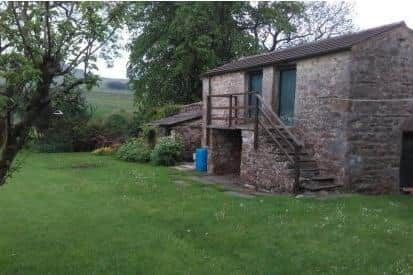Rowe House: Yorkshire Dales B&B owners allowed to keep converted historic outbuildings as holiday let - but must reinstate original steps
Robert and Jane Burdett applied retrospectively to the Yorkshire Dales National Park Authority for consent to work that had already been completed to a former stable and privy at the rear of The Rowe House in Horton-in-Ribblesdale – a former Georgian shooting lodge. They marketed the annexe as a self-contained let called The Shippon.
However, in June the Authority's planners ruled that the scheme had caused 'significant harm' to the heritage of the 19th-century buildings and councillors agreed with their recommendation for refusal.
Advertisement
Hide AdAdvertisement
Hide AdConcerns were raised about the removal of a flight of original stone steps and the erection of a timber walkway to link the buildings.


In August, the couple resubmitted their application, arguing that the stable had in fact been a coal store and that they did not know they required consent for the construction work. They added that the buildings had been disused and in poor condition and had been rescued by the conversion project.
On October 31 the Authority agreed to approve the proposal on the condition that the original steps were reinstated.
The most recent planning officers’ report reads: “The current application is the same as the previous one apart from two key points. Firstly, a detailed heritage impact assessment has been supplied by a heritage specialist and secondly the application includes a proposal to reinstate a set of stone steps that were removed from the front elevation of one of the buildings. The heritage statement finds that Rowe House has a local significance in heritage terms but that the two buildings to the rear that have been converted into the holiday let have very little historical interest.
Advertisement
Hide AdAdvertisement
Hide Ad"The statement finds that the alterations have been beneficial in that they have secured the future of the buildings and allowed them to be used and
appreciated by visitors staying at the site. The statement further considers that the reinstatement of the external stone steps would be a benefit. Overall, the report considers that the conversion of the two buildings has been beneficial for the significance of Rowe House because the buildings- one of which was deteriorating and required work have been saved and continue to contribute to the setting of Rowe House as buildings that can still be read as minor ancillary buildings subservient to the main house.
“The two main aspects of concern with the previous application related to the timber link as an incongruous feature and the removal of the external steps. While the timber link remains in position as part of this application there is a proposal this time to reinstate the stone steps. This results in one feature of concern remaining. The heritage statement identifies that the two buildings were at one time linked - this appears to be the case from the 1950s OS map and a map used in an earlier planning application. However, they were not linked in the manner of the new timber element that projects forwards. It is also notable that the plans also showed that the smaller building was either to be demolished or altered significantly as part of a consent for more significant development in the grounds of Rowe House.
“The Heritage Statement considers that the linking structure has secured a positive beneficial use for the two outbuildings and that this has a beneficial heritage impact. The statement also notes that the removal of the stone steps has had an adverse heritage impact. However, their replacement would result in a beneficial heritage impact. The overall conclusion is that the works and what is now proposed will have a considerable beneficial heritage impact. In the light of this and on discussion with the Historic Buildings Officer it is considered that the proposal is acceptable provided the steps are
installed.”
Rowe House was built in the late 18th century as the shooting lodge for an Arncliffe landowning family. It was later sold at auction in the 1950s and has been a B&B since the 1980s.
